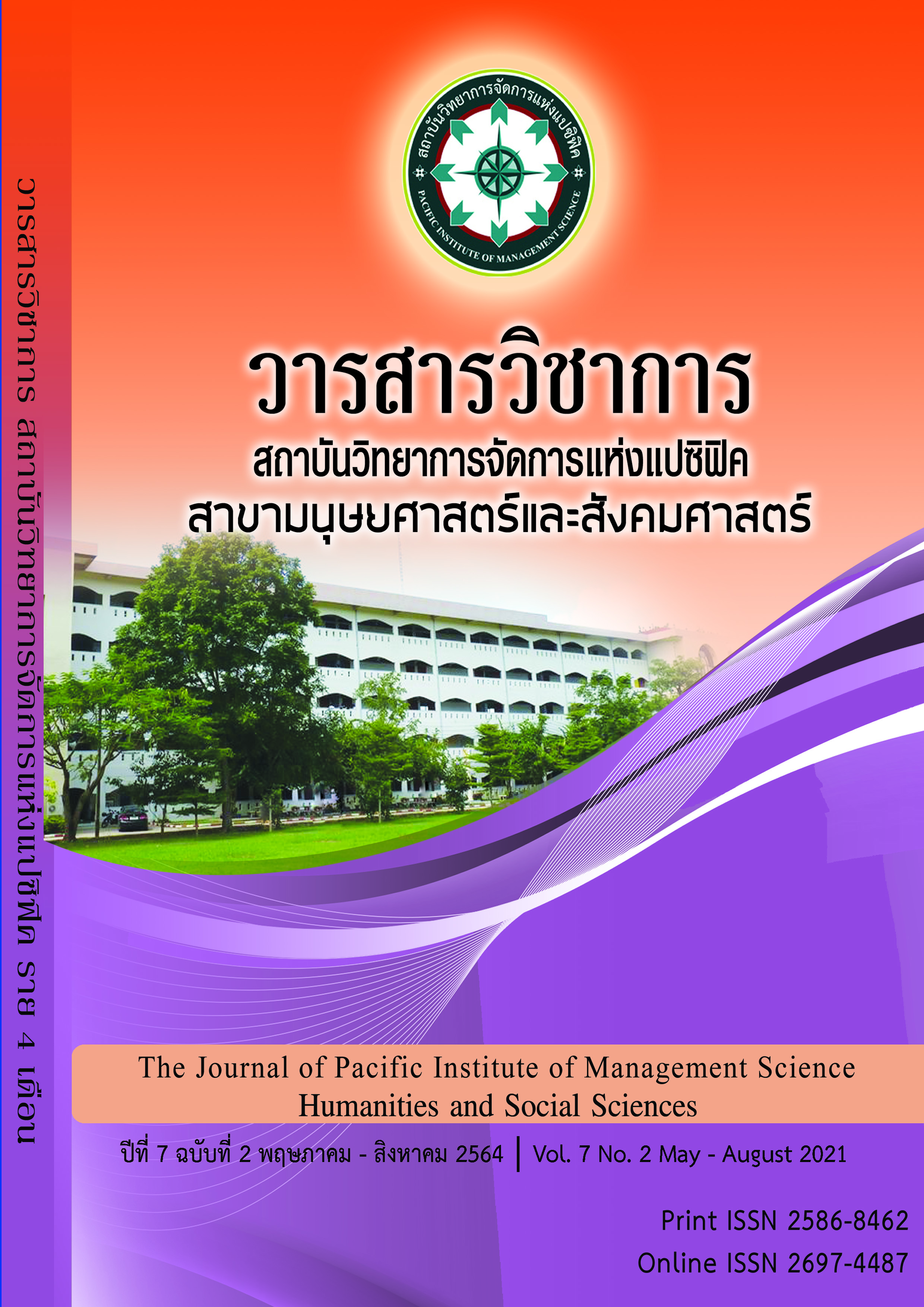The Study of Pronunciation Ability for Early Consonant Phonemes of Autistic Children Using Commute-Assisted Special Education Chonburi Province Sattahip Service Unit
Keywords:
Early consonant phonemes, Computer assistedAbstract
The objectives of this research is 1) To establish and find the effectiveness of computer assisted instruction on the study of phonetic ability of early consonant phonemes. Of autistic children using computer assisted lessons of the Special Education Center, Education District 12, Chonburi Province Sattahip Service Unit to be effective in accordance with the 80/80 2) To study the ability to pronounce the initial consonant phonemes of autistic children Special Education Center, Education District 12, Chonburi Province Sattahip Service Unit after teaching by using computer assisted instruction. ; and 3) To compare the early phonetic units of the autistic children Special Education Center, Education District 12, Chonburi Province Sattahip Service Unit before and after teaching by using computer assisted lessons. The sample used in the research are autistic children aged 5-6 years studying in Special Education Center, Education District 12, Chonburi Province Sattahip Service Unit under the office of Special Education Administration office of the basic education commission ministry of education, semester 1-2, academic year 2019, no duplicate disabilities have the ability to pronounce vowels. But cannot pronounce consonants have basic knowledge of computer use. This was obtained by selecting a specific by purposive sampling technique. A sample used to find efficacy. There were three groups of computer assisted pronunciations in the first semester of the academic year 2019, which consisted of 3 people used in the single performance test, the group used for the performance test in groups of 7 people and the group. The samples were used in the field performance testing of 10 people, including 20 people and a sample of study of the ability and comparing the pronunciation ability of the initial consonant phonemes. Before and after teaching by using computer assisted lessons in the second semester of the academic year 2019, 6 students were employed. The research tools were the learning management plan on pronunciation, the early consonant units. Individual education management plan individual lesson plans computer-assisted lessons teach the pronunciation of the early consonant phonemes. The research results were found that 1) The computer-assisted lessons on pronunciation of the early consonant phonemes were of very good quality. Achieved standard performance of 85.88/84.85 2) The ability to learn how to pronounce the first consonant unit of autistic children Special Education Center, Education District 12, Chonburi Province Sattahip Service Unit after teaching by using computer assisted instruction good level 3) The ability to learn how to pronounce the first consonant unit of autistic children Special Education Center, Education District 12, Chonburi Province Sattahip Service Unit using computer assisted lessons significantly higher after study at the .05 level.
References
ชุติมา ศิริธรรมขันติ. การพัฒนาบทเรียนคอมพิวเตอร์ช่วยสอนเรื่องระบบเครือข่าย
คอมพิวเตอร์สำหรับนักเรียนในช่วงชั้นที่ 4. วิทยานิพนธ์ ครุศาสตรมหาบัณฑิต
มหาวิทยาลัยราชภัฏนครปฐม, 2560.
ดรุณวรรณ แก้วหนูนวล. (2557). การพัฒนาสื่อประสมเพื่อฝึกการพูดสำหรับเด็กออทิสติก
โรงเรียนสาธิตแห่งมหาวิทยาลัยเกษตรศาสตร์ ศูนย์วิจัยและพัฒนาการศึกษา.
วิทยานิพนธ์ ศึกษาศาสตรดุษฎีบัณฑิต มหาวิทยาลัยเกษตรศาสตร์.
จารุวัชร ภูมิพงศ์ (2562 : 47). การศึกษาความสามารถอ่านคำภาษาอังกฤษอนักเรียนที่มีปัญหาด้านการอ่าน ระดับชั้นมัธยมศึกษาตอนต้น โดยใช้วิธีการสอนอ่านแบโฟนิกส์ร่วมกับเทคโนโลยีโลกเสมือนผสานโลกเสมือนจริง. วารสารวิจัยและพัฒนาการศึกษาพิเศษ มหาวิทยาลัยศรีนครินวิโรฒ. ปีที่ 8 (2562). ฉบับที่ . หน้า 47
ทวิช ตรีสูน. (2562). การใช้แท็บเล็ตเพื่อการพัฒนาการสื่อสารทางวาจาของนักเรีนที่มีภาวะออทิสซึมด้วยความร่วมมือของครูและผู้ปกครอง. วารสารวิจัยและพัฒนาการศึกษาพิเศษ มหาวิทยาลัยศรีนครินวิโรฒ. ปีที่ 8 (2562). ฉบับที่ 2. หน้า 21.
อาทิตยา เล็งเจ๊ะ (2560 : 61) การศึกษาความสามารถทางการอ่านองนักเรียนที่มีความบกพร่องทางด้านการเรียนรู้โดยใช้ชุดนิทานคำคล้องจอง วารสารวิจัยและพัฒนาการศึกษาพิเศษ มหาวิทยาลัยศรีนครินวิโรฒ. ปีที่ 6 (2560). ฉบับที่ 2. หน้า 61
ศรีวิมล มโนเชี่ยวพินิจ. (2552). เอกสารประกอบการอบรมการใช้โปรแกรมการประเมิน
เสียงพูดภาษาไทย. กรุงเทพฯ : มหาวิทยาลัยมหิดล.
ไชยยศ เรืองสุวรรณ. (2552). คู่มือกิจกรรมการเรียนการสอนคอมพิวเตอร์เพื่อการศึกษา.
มหาสารคาม : มหาวิทยาลัยมหาสารคาม.
เดือนฉาย แสงรัตนายนต์. (2551). คู่มือฝึกพูดเด็กออทิสติกสำหรับผู้ปกครอง. กรุงเทพฯ :
โรงพยาบาลยุวประสารทไวทโยปถัมภ์.
Bernard-Opitz V, Sriram N, Nakhoda-Sapuan S. (2001) Enhancing social problem
solving inchildren with autism and normal children through computer-assisted instruction. J AutismDev Disord 31:377–384.
Haugsness, G. A. (1988). Effect of Computer-Assisted Instruction on secon dary
reading students. Dissertation Abstracts International.
Katz, R.L. (2001). Skill of Effective Admnistrator. Harvard Business Review.
Executive Success Marking it in Management. 32 (2) : 90-102)
Downloads
Published
Issue
Section
License
Copyright (c) 2021 Pacific Institute of Management Science

This work is licensed under a Creative Commons Attribution-NonCommercial-NoDerivatives 4.0 International License.
บทความที่ได้รับการตีพิมพ์เป็นลิขสิทธิ์ของ สถาบันวิทยาการจัดการแห่งแปซิฟิค
ข้อความที่ปรากฏในบทความแต่ละเรื่องในวารสารวิชาการเล่มนี้เป็นความคิดเห็นส่วนตัวของผู้เขียนแต่ละท่านไม่เกี่ยวข้องกับสถาบันวิทยาการจัดการแห่งแปซิฟิค และคณาจารย์ท่านอื่นๆในสถาบันฯ แต่อย่างใด ความรับผิดชอบองค์ประกอบทั้งหมดของบทความแต่ละเรื่องเป็นของผู้เขียนแต่ละท่าน หากมีความผิดพลาดใดๆ ผู้เขียนแต่ละท่านจะรับผิดชอบบทความของตนเองแต่ผู้เดียว







